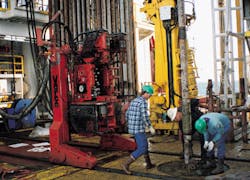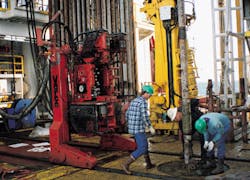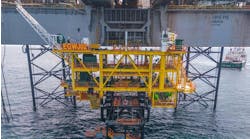Vessel drill floor automation clearing the decks for deepwater
Safety first, but speed a close second
William Furlow
Technology Editor
The iron roughneck makes up and breaks out pipe at the touch of a button.
Automation on the drill floor is rapidly transforming the deepwater drilling practice as operators race into deeper and deeper water. What began as an issue of worker safety is growing into a question of speed and efficiency on the critical path.
Recent innovations that will premier on upcoming deepwater newbuilds allow drillers to rack back triple stands of pipe and double stands of casing without interrupting drilling operations. Still questions remain. Can these new efficiencies offset the additional cost of technology? Can a floater make hole fast enough to justify two derricks?
Jerry Gill, who has been with Varco for 40 years, and there at the beginning of rig-floor automation, said "in the early days, one could spot an old-time driller by his missing fingers." Use of spin chains, open catheads, and manual tongs left drillers with little margin for error and the unforgiving steel sent many a rough neck home minus a digit.
While this system of manually spinning and torquing drill pipe was inexpensive, simple, and in most cases incredibly fast, it was subject to human error. The rhythm roughnecks fall into when tripping pipe has been described as a dance, spinning the chain, torquing the pipe, pulling the slips. Drillers making the same motions so many times, it becomes automatic. It was a natural progression from this very fast manual exercise to automation of these activities.
Three major tools
In the mid-1960s, the hydraulic kelly spinner was introduced into the market to replace the spin chain. This was followed in the early 1970s with the hydraulic pipe spinner or spinning wrench, and the torque wrench replaced the manual tongs. These three tools were further perfected and then combined into a single carriage, the first generation of what has become known almost generically as the "iron roughneck." In its initial form, this hydraulic tool was operated by levers on the drill floor. It offered greater safety for the roughnecks, and provided more uniform connections of the drill pipe. Varco sold more than 1,200 of these original iron roughnecks.Gill said the oil industry is slow to adapt to change. In situations where an existing system has historically worked well, it is difficult to convince the industry to adopt new practices. Varco introduced these innovations in what Gill calls modules. These are incremental improvements to the existing system, allowing gradual adaptation of the new technology.
As newer versions of the iron roughneck hit the market, automation slowly replaced manual spin chain activities on the drill floor. Gill said Varco has introduced five versions of the iron roughneck since 1978, each building on the innovations of the previous tool, improving efficiency and safety. These later versions are electronically controlled and push button operated, able to make-up and break-out pipe spinning connections in and out with one automated tool.
Set on the breakout mode, the iron roughneck will move out onto the rotary table until it finds the pipe. It will either make up or break out the pipe depending on the setting. In the breakout mode, once the connection is broken, the pipe spinner will automatically be activated to spin the pipe out of the connection.
Pipe handling function
The next step in automation came with the pipe handling machine (PHM). While the iron roughneck could make-up and break out connections and spin pipe, the PHM could lift the pipe, turn it around, and rack it back in the derrick. This tool could also position the pipe on the drill floor.This innovation eliminated two positions where the derrick man had to run the monkey board placing pipe, and a roughneck positioning pipe on the rotary table. The Star racking system was then developed to automatically rack back pipe in a star configuration. This system was less expensive than the original PHM, but the star pattern could not hold as much pipe.
These earlier designs then gave way to the modern pipe racking system (PRS), versions of which are now seen on 90% of automated rig floors. The PRS would allow for automated racking of triples and even quads in the derrick. The PRS3 operated as a separate tool from the iron roughneck and was able to rack pipe in a conventional pattern. From this tool came the PRS4 which could rack in a parallel configuration. This allowed for more storage space on the derrick and maximized the efficiency of storage on the space provided on the drill floor.
Off the critical path
From these innovations came the concept of making up pipe and casing off the critical path. Because all but a few rigs have gone to top drives, it is necessary to trip pipe in triple strings. To avoid the costly downtime of making up singles into triples on the drill floor, the next generation of PRS was designed to make up and lay back these stands of pipe off the critical path, allowing drilling to continue virtually uninterrupted.This was achieved by installing a second PRS on the drill floor to handle the pipe. This time savings is compounded by automation because the pipe is later broken out and racked back in triple or quadruple stands, eliminating the time previously devoted to breaking these triples into singles for storage. One of the keys to being able to store these triple strings was creating a more sturdy rack to hold the longer, heavier strings. With the exception of the Glomar Explorer, which stores its pipe horizontally this is the standard configuration for deepwater vessels.
Additional time savings can be realized in the handling of bottom hole assemblies. There are normally six to nine stands of drill collars. Breaking out these joints requires a massive amount of torque since they lead the drill string and are very heavy even by oil field standards. Traditionally, the BHA would be broken out by dropping the slips, putting the safety clamp on, putting the tongs on, letting them bite, "Then everybody runs for cover," Gill said.
The high level of torque and power needed to break out these joints made it a dangerous operation. Even after the BHA is broken out, the roughnecks still had to get the joints over to the rack. These are extremely heavy by design. They were lifted using an air hoist, called a "mule." This was operated by a man on the monkey board who slowly moved the joints back from the rotary table to the rack. It was a very dangerous and time consuming operation.
Using the iron roughneck and PRS there is virtually no difference in breaking out and setting back the BHA and any other joint of pipe. These automated tools have the capacity to handle the weights and torque of this string with ease, cutting down on the danger and time involved in handling the BHA.
Using a second PRS, with additional tools, double joints of casing can also be racked back in the derrick ahead of time, or during drilling, effectively cutting the time spent running casing in half depending on how many joints are racked back. All of these activities require only the driller, assistant driller and one man on the rotary table to dope and inspect the shoulder connections. The driller and assistant driller are operating from the safety and comfort of enclosed cabs.
This automated equipment also eliminates many of the delays experienced by a manual crew during adverse weather conditions. The automated equipment is not affected by weather. Another factor to consider is experience. With the cyclical nature of the industry it is difficult to find experienced drillers on short notice. This automated equipment simplifies the procedures so that a trained worker with relatively little experience can perform almost as well as his experienced counterpart.
Deepwater advantages
It is no coincidence that the majority of newbuild deepwater drilling rigs will be equipped with extensive rig floor automation. Many of these new designs feature dedicated space, dual derricks, and peripheral stations to take the greatest advantage of these innovative and time saving designs. As a driller moves into deeper water, he is not just racking pipe for the hole drilled below the mudline, but as much as an additional mile of pipe running from the vessel to the seabed. This requires additional space for racking, which parallel racking provides.Another consideration is landing casing strings that approach a million pounds. While these strings have traditionally been lowered on conventional drill pipe, these new, longer strings weigh too much for traditional pipe. That means an additional landing string made of stronger pipe to land these strings. That further adds to the racking space requirements for deepwater rigs.
The spider sits on the drill floor over a 60 ft tubular mouse hole for the drill pipe. The driller sets one joint of pipe in the mouse hole, sets the slips, makes up the second joint of pipe, pulls the slips, lowers the two strings, then makes up the third joint. The spider is designed to handle strings of casing with a different set of slips so the double stands of casing can be made up and set back.
In addition, the automated drill floor includes a system to fill-up casing as it is set. Traditionally the casing is filled with drilling fluid before being run into the hole preventing the casing from being crushed as it is run. This filling process however delays the casing run. Using a top drive allows the casing to be filled as it is continually tripped into the hole saving even more time.
Dual derrick systems
The new generation of deepwater drillships and semis includes a number of systems that feature dual derrick and multiple tubular stations. The theory is that these systems will allow a driller time to make up and set back casing and drill pipe while drilling continues. Drilling a 17 1/4-in. hole in the US Gulf of Mexico usually goes very fast. This gives the driller little time to make up and rack back 13 3/8 in. casing. With two separate rig floors one can be devoted to tripping and drilling, while the other is used for making up pipe and casing.Once the drilling program reaches the 9 5/8 in. hole, the drilling has slowed down and there is some question whether the additional capacity of the second derrick will be fully utilized during these periods. The additional cost of a second system has to be calculated into the overall time savings.
In some cases, this second drill floor allows for a completely new approach to drilling and landing equipment. The second derrick is not only used to make up and set back tubulars, but also to lower equipment, such as a subsea blowout preventer (BOP) while drilling is still underway. This would offer additional time savings regardless of how slowly the drilling is progressing.
The most extreme of these redundant drill floor systems is the Sedco Express. This new generation semisubmersible has two porches where pipe can be made up and laid back while drilling on the main drill floor continues uninterrupted. The question is will these innovative, and costly, new designs pay off in the real world market, or will they prove to have more capacity that the drilling program requires.
Copyright 1999 Oil & Gas Journal. All Rights Reserved.




